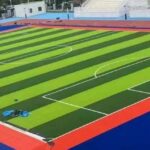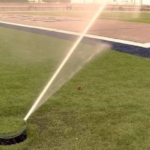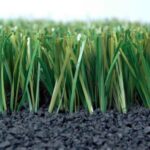Spatial prediction of representative scenes: Synchronous penetration of artificial turf indoor and outdoor scenes

1. Estimated US yard usage
Estimated US yard usageIn 2020, the US will sell 6.65 million new homes and 940,000 second-hand homes, totaling about 7.6 million units. Assuming that a single household uses a lawn of 30 square meters and is calculated at an ex-factory price of 35 yuan per square meter, the total potential space corresponds to RMB 8 billion. According to the penetration rate, The corresponding space of 10%, 20%, and 30% is estimated to be 800 million yuan, 1.6 billion yuan, and 2.4 billion yuan.
2. Infer the pet straw space
United States: According to the 2019-2020 APPA National Pet Owner Survey, 67% of households in the United States own pets, equivalent to 84.9 million households. Among them, dog-raising households and cat-raising households were 63.4 million and 42.7 million respectively. Quantitatively, there are 97 million dogs and 76 million cats in the United States, respectively. Corresponding to the potential usage of 152 million pieces of lawn/grass mats for pets (one piece of grass bed for each piece), assuming a unit price of US$15 per piece (different specifications and prices), corresponding to a potential space of US$2.3 billion, using 5%, 10%, and 20% The penetration rate speculation space is 200 million US dollars, 500 million US dollars, and 700 million US dollars.
Domestic: According to the “2020 White Paper on China’s Pet Industry”, in 2020, the number of pet dogs and cats in China will exceed 100 million, and the number of pet owners will reach 62.94 million. Corresponding to 100 million potential pet-specific lawns/straw mats (one grass mat for each), assuming a unit price of 50-100 yuan/piece (different specifications), corresponding to a potential space of 5-10 billion yuan, assuming a total space of 5 billion yuan With the penetration rate of 5%, 10%, and 20%, it is estimated that the space is 500 million yuan, 1 billion yuan, and 1.5 billion yuan, respectively.
3.Estimate the potential usage of domestic kindergartens
Kindergartens do not use professional sports turf, we define it as leisure grass, but because children use it, the product requirements are higher than other leisure categories. According to the National Education Development Statistical Bulletin, there will be 291,700 kindergartens in China in 2020. Assuming that a single kindergarten contains 200 square meters of lawn, corresponding to 0.03 standard football fields, the total national content is about 8,800. It is assumed that the cost of artificial grass is 40 yuan/square meter (for children The standard is higher), with a total space of 2.5 billion yuan.

The artificial turf market is globalized, and the Chinese manufacturing dividend is outstanding
The artificial turf market has the characteristics of globalization, involving hundreds of countries and regions, and has formed two industry practices for a long time: the global industrial chain division of labor and cooperation and OEM sales, especially in the field of recreational grass.
1. Division of labor and cooperation in the global industrial chain
If you directly connect with terminal consumer groups, you need to fully understand the cultural customs and consumption habits of various countries/regions, which is a huge challenge for production enterprises. The division of labor in the industrial chain is more effective, and intermediate channels emerge as the times require: artificial grass wholesalers and artificial grass paving. business, connecting the production end and the consumer market. Wholesalers generally do not process artificial turf products.
Single small-scale purchases have stable overall frequency and large cumulative scale; pavers are engineering contractors. After purchasing artificial turf, fillers, elastic pads, and other materials, they provide site design for end customers. , paving and maintenance, the single scale is large but the frequency is unstable. The main product sold to wholesalers at home and abroad is leisure grass, and the main product sold to pavers is sports grass. The general correspondence is leisure grass→wholesaler, sports grass→pavers.
2. Artificial grass OEM mode
In the recreational grass market, compared with manufacturers, artificial grass wholesalers have a deeper understanding of regional needs and have stronger channel capabilities to promote products. From the perspective of a wholesaler, owning a brand by yourself is more attractive than introducing a brand, in case the supplier can be changed without changing the brand in the future, reducing the right to speak in upstream (if the manufacturer is an ODM, the R&D and design ability will enhance the right to speak) ).
At the same time, the use of foreign brands does not result in a significant premium, so there is no need to retain foreign brands. For manufacturers, there is no need to set up transit warehouses, sales outlets, and supporting sales personnel by themselves, and they can also control product promotion expenses and reduce management difficulties. In the sports grass market, terminals are not sensitive to price, and there are qualification certifications. Manufacturers have a stronger sense of brand presence due to technology and their right to speak. It is difficult for pavers to “de-brand”, and the dependence relationship is stronger.
The field of recreational grass needs to emphasize two capabilities:
One is to track demand and R&D capabilities. Quick response is reflected in receiving demand signals and rapidly developing samples. It is essentially positive feedback between sales and R&D and shows small batch production capacity with the help of cost advantages.
The second is a relative advantage. Companies with relative R&D strength have cost advantages, and companies with similar relative costs have R&D and response advantages.
Due to different regions, “passive” has become a “non-standard product”. Different grass species in different places, to achieve the simulation effect, it is required to be close to the color, state, height, etc. of the local grass, and it changes according to the season. Therefore, artificial grass is not a general-purpose product, but a regional product. In addition, due to the abundance of scenarios, “passive” has become “non-standard products”, and application scenarios are constantly being developed. Upstream manufacturers are required to respond to regional needs or the needs of certain groups of people in a timely and accurate manner, develop products and mass-produce them.
The low-end demand in the field of recreational grass is relatively large, and it has the characteristics of non-professional consumers and high-frequency replacement, which will reduce the use requirements accordingly. Different suppliers have different attitudes: small profits but quick turnover, or enter the high-end high-margin market through technology and channel investment. We believe that the latter is more based on the long-term, especially cultivating overseas high-end customers, which requires quality assurance, and at the same time, product technology and application keep pace with the times and even lead the industry.
Click here to view the last episode.
The above information data comes from the Internet.



